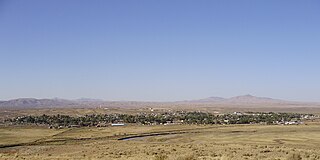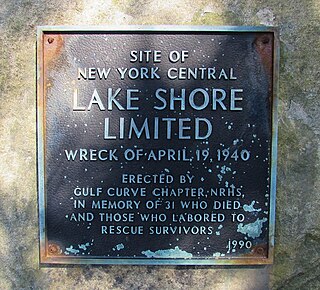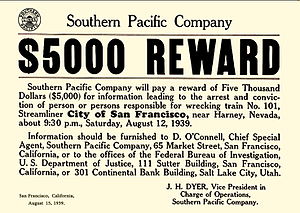
Carlin is a small city located near the western border of Elko County in northeast Nevada, 23 miles (37 km) west of the city of Elko. It is part of the Elko Micropolitan Statistical Area. Carlin sits along Interstate 80 at an elevation of approximately 4,900 feet (1,500 m). As of the 2010 census, its population was 2,368, up from 2,161 at the 2000 census. The city was named for Civil War general William Passmore Carlin. Its slogan is "Where the Train Stops...And the Gold Rush Begins".

The Southern Pacific was an American Class I railroad network that existed from 1865 to 1996 and operated largely in the Western United States. The system was operated by various companies under the names Southern Pacific Railroad, Southern Pacific Company and Southern Pacific Transportation Company.

The California Zephyr was a passenger train that ran between Chicago, Illinois and Oakland, California via Omaha, Denver, Salt Lake City, Winnemucca, Oroville and Pleasanton. It was operated by the Chicago, Burlington & Quincy (CB&Q), Denver & Rio Grande Western (D&RGW) and Western Pacific (WP) railroads, all of which dubbed it "the most talked about train in America" on March 19, 1949, with the first departure the following day. The train was scheduled to pass through the most spectacular scenery on its route in the daylight. The original train ceased operation in 1970, though the D&RGW continued to operate its own passenger service, the Rio Grande Zephyr, between Salt Lake City and Denver, using the original equipment until 1983. In 1983 a second iteration of the California Zephyr, an Amtrak service, was formed. The current version of the California Zephyr operates partially over the route of the original Zephyr and partially over the route of its former rival, the City of San Francisco.

Beowawe is a small town in Eureka County, Nevada, United States.

The Atchison, Topeka and Santa Fe Railway, often referred to as the Santa Fe or AT&SF, was one of the larger railroads in the United States. The railroad was chartered in February 1859 to serve the cities of Atchison and Topeka, Kansas, and Santa Fe, New Mexico. The railroad reached the Kansas–Colorado border in 1873 and Pueblo, Colorado, in 1876. To create a demand for its services, the railroad set up real estate offices and sold farmland from the land grants that it was awarded by Congress.

The Coast Daylight, originally known as the Daylight Limited, was a passenger train on the Southern Pacific Railroad (SP) between Los Angeles and San Francisco, California, via SP's Coast Line. It was advertised as the "most beautiful passenger train in the world," carrying a particular red, orange, and black color scheme. The train operated from 1937 until 1974, one of the few passenger trains retained by Amtrak in 1971. Amtrak merged it with the Coast Starlight in 1974.
The 1995 Palo Verde derailment took place on October 9, 1995, when Amtrak's Sunset Limited was derailed by saboteurs near Palo Verde, Arizona on Southern Pacific Railroad tracks. Two locomotives, Amtrak GE P32-8BWH #511 leading and EMD F40PHR #398 trailing, and eight of twelve cars derailed, four of them falling 30 feet off a trestle bridge into a dry river bed. Mitchell Bates, a sleeping car attendant, was killed. Seventy-eight people were injured, 12 of them seriously and 25 were hospitalized.

The City of San Francisco was a streamlined through passenger train which ran from 1936 to 1971 on the Overland Route between Chicago, Illinois and Oakland, California, with a ferry connection on to San Francisco. It was owned and operated jointly by the Chicago and North Western Railway (1936–55), Chicago, Milwaukee, St. Paul and Pacific Railroad (1955–71), the Union Pacific Railroad, and the Southern Pacific Railroad. It provided premium extra fare service from Chicago to San Francisco when introduced in 1936 with a running time of 39 hours and 45 minutes each way.

The “Northwestern Pacific Railroad” was a 271 mile mainline railroad from the ferry connections in Sausalito north to Eureka with a connection to the national railroad system at Schellville. The railroad has gone through a history of different ownership and operators but has maintained a generic name of reference as “The Northwestern Pacific.” Currently, only a 62-mile (100 km) stretch of mainline on the “South End” is operated by Sonoma-Marin Area Rail Transit (SMART), which operates both commuter and freight trains with plans for future extension north to Cloverdale. The “North End,” from Willits to Eureka which includes connections to the California Western Railroad] is currently out of service but saved by 2018 legislation to be converted into the Great Redwood Trail.

The Carlin Tunnel is a collective name for a set of four tunnel bores in the Humboldt River's Carlin Canyon, east of Carlin in Elko County, Nevada, United States. The two railroad bores were constructed for different purposes at different times, while the two highway bores were constructed concurrently, all with the goal of bypassing a sharp bend in the river. Currently, two of the bores carry Interstate 80, while the other two bores carry Union Pacific Railroad's Overland Route and Central Corridor. Bridges over the Humboldt River are adjacent to both portals of three tubes, including the two freeway bores and one of the railroad bores.

The Overland Route was a train route operated jointly by the Union Pacific Railroad and the Central Pacific Railroad / Southern Pacific Railroad, between Council Bluffs, Iowa / Omaha, Nebraska, and the San Francisco Bay Area, over the grade of the first transcontinental railroad which had been opened on May 10, 1869. Passenger trains that operated over the line included the Overland Flyer, later renamed the Overland Limited, which also included a connection to Chicago. Although these passenger rail trains are no longer in operation, the Overland Route remains a common name for the line from Northern California to Chicago, now owned entirely by the Union Pacific. Although now primarily used for freight, a few portions still provide the route for the California Zephyr passenger train.
The Frankford Junction train wreck occurred on September 6, 1943, when Pennsylvania Railroad's premier train, the Congressional Limited, crashed at Frankford Junction in the Kensington neighborhood of Philadelphia, Pennsylvania in the United States, killing 79 people and injuring 117 others.
The Exposition Flyer was a passenger train jointly operated by the Chicago, Burlington & Quincy (CB&Q), Denver & Rio Grande Western (D&RGW), and Western Pacific (WP) railroads between Chicago and Oakland, California, for a decade between 1939 and 1949, before being replaced by the famed California Zephyr.

A train crash with fatalities occurred shortly after 11:30 p.m. on April 19, 1940, when a first-class westbound Lake Shore Limited operated by the New York Central Railroad, derailed near Little Falls, New York, United States. The accident was later found to have occurred due to excessive speed on the Gulf Curve, the sharpest on the Central's lines. It killed 31; an additional 51 were injured.

Rail sabotage is the act of disrupting a rail transport network. This includes both acts designed only to hinder or delay as well as acts designed to actually destroy a train.

The California Zephyr is a long-distance passenger train operated by Amtrak between Chicago and the San Francisco Bay Area, via Omaha, Denver, Salt Lake City, and Reno. At 2,438 miles (3,924 km), it is Amtrak's longest daily route, and second-longest overall after the Texas Eagle's triweekly continuation from San Antonio to Los Angeles, with travel time between the termini taking approximately 511⁄2 hours. Amtrak claims the route as one of its most scenic, with views of the upper Colorado River valley in the Rocky Mountains, and the Sierra Nevada. The modern train is the second iteration of a train named California Zephyr; the original train was privately operated and ran on a different route through Nevada and California.

On the night of Wednesday, June 21, 1905, the New York Central Railroad's flagship passenger train, the 20th Century Limited, derailed in Mentor, Ohio, on the Lake Shore and Michigan Southern Railway line, killing 21 passengers and injuring more than 25 others on board. A switch from the mainline to a freight siding was open, causing the Limited to leave the mainline and overrun the siding at high speed. The cause of the accident was never officially determined, but overwhelming evidence points to an act of rail sabotage. The 20th Century Limited connected New York City to Chicago; its running time had just weeks earlier been reduced from 20 hours to 18.
The Elko Subdivision is a railway line in Nevada owned and operated by the Union Pacific Railroad running from Weso to the freight yard in Elko. It is part of both the Overland Route and the Central Corridor. The line generally follows the Humboldt River and has several small tunnels while traversing the Palisade and Carlin Canyons, the longest tunnel is called the Carlin Tunnel.














